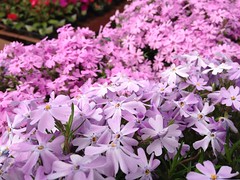Creeping Phlox

Creeping phlox produces a colorful spring carpet of soft pastel hues. The great thing about creeping phlox is its easy care. You don’t need to be a professional gardener to enjoy its beauty.
Growing creeping phlox over a rockery or in tough soil conditions provides a nearly carefree ground cover or cascading plant. In our area creeping phlox does a great job on slopes that may be a pain to mow. Using creeping phlox on slopes also has the added benefit of helping prevent soil erosion.
A perennial nature and semi-evergreen habit are important facts about creeping phlox. These plants have needle-like foliage with small starry, five-pointed flowers in red, lavender, pink, white, or bluish-purple. Creeping phlox blooms in spring and produces long, spreading stems, which become woody with age.
These thicker growths cease to produce flowers over time and may be cut out of the plant to encourage the newer, softer stems that do bloom. In addition, the plant has a moderate growth rate and can get 4 to 6 inches high with a 2 foot spread.
Learning how to plant and care for creeping phlox is quite simple. The plant has an easy going nature and thrives in a variety of conditions. Almost any soil is suitable for growing creeping phlox as long as it is in full sun to partial shade. For best results, however, plant it in a sunny location where soils are moist but well drained.
 Little special care or maintenance is necessary when growing creeping phlox. The plant benefits from an early spring application of fertilizer to encourage new growth and flowering.
Little special care or maintenance is necessary when growing creeping phlox. The plant benefits from an early spring application of fertilizer to encourage new growth and flowering.
Even established plants should have supplemental watering in hot summer periods and plants along rockeries may show signs of scorching due to the hot surroundings.
The stems can be cut back after flowering to promote a second bloom. Care of creeping phlox may also include cutting the plant back in late winter to allow for rejuvenation and to produce young, more compact stems.
Watching for mites and other pests and dealing with these infestations as soon as they are spotted using an organic insecticidal soap is also important for the plant’s care.
The plant can also be divided to provide more growing creeping phlox plants. Simply dig the plant up, preserving the root ball. Cut through the center of the plant and through the roots with a sharp soil knife or even a spade. Replant one-half of the phlox in the original hole and plant the other anywhere you want more of the colorful ground cover. The process can be done every few years to create healthier plants.